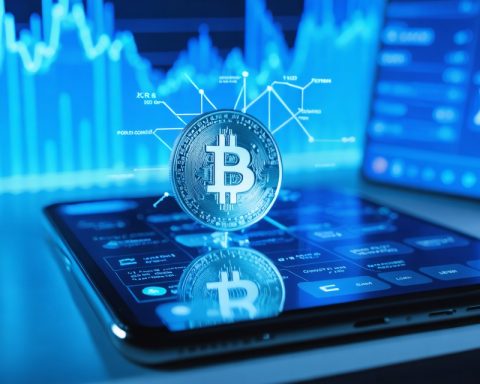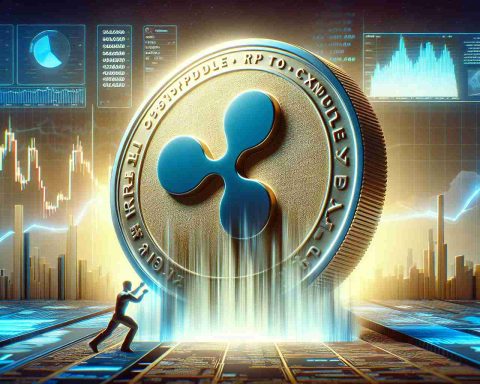- Ripple’s XRP surged by 10%, surpassing Tether to become the third-largest cryptocurrency with a market cap exceeding $152 billion.
- The SEC’s response to Grayscale’s proposal to convert its XRP Trust into an ETF may have sparked this growth, indicating potential regulatory favor.
- Approval of an XRP ETF could simplify access for investors, enhancing market interest significantly.
- Ripple’s CEO envisions a future where other cryptocurrencies, like Solana and Cardano, enter the ETF market.
- The potential SEC regulatory shift might influence the ongoing Ripple v. SEC lawsuit, possibly leading to a resolution.
- XRP’s ascent highlights the unpredictable nature of the crypto market and the importance of staying vigilant for emerging opportunities.
The world of cryptocurrencies often delivers surprises that catch even seasoned investors off guard. In a market mostly quiet over the last 24 hours, Ripple’s XRP has emerged as the unlikely hero, soaring by 10% and effortlessly dethroning Tether (USDT) to claim the title of third-largest cryptocurrency. As coins like Bitcoin and Ethereum tread water, XRP surges ahead, gleaming with a fresh market capitalization of over $152 billion.
The catalyst behind this bold ascension seemingly lies in the unexpected nod from the US Securities and Exchange Commission (SEC) towards Grayscale’s application to transform its XRP Trust into an exchange-traded fund (ETF). Though this acknowledgment does not equate to outright approval, it sets the stage for a thorough review process that many believe could end favorably for Ripple. An official go-ahead could revolutionize access to XRP, enticing a wave of investors eager to gain exposure without directly engaging in the complexities of cryptocurrency handling.
Meanwhile, Ripple’s CEO strikes a confident posture, having long predicted the inevitability of such developments. His outlook extends beyond XRP, hinting at a future where cryptocurrencies like Solana and Cardano might also join the ETF brigade.
Amidst conjectures and calculations, the XRP community buzzes with optimism. Could this regulatory shift also sway the ongoing Ripple v. SEC lawsuit towards a resolution? Observers think so, theorizing that a case drop might be on the horizon.
In an industry known for its volatility, Ripple’s rise offers a straightforward reminder: opportunities abound, often appearing when least expected. As the XRP narrative unfolds, market watchers would do well to keep their expectations varied and their eyes wide open.
Ripple’s Meteoric Rise: What This Means for Crypto Investors
How-To Steps & Life Hacks: Investing in XRP ETFs
With the potential SEC nod towards Grayscale’s XRP Trust as an ETF, here’s a streamlined guide to getting involved:
1. Stay Informed: Regularly check updates from credible sources about the SEC review of Ripple’s ETF proposal.
2. Choose a Broker: Find a brokerage that offers access to cryptocurrency ETFs.
3. Understand the Risks: ETFs carry both market and regulatory risks. Be sure to understand these before investing.
4. Diversify Your Portfolio: Don’t put all your eggs in one basket. Include a variety of assets to mitigate potential losses.
5. Monitor Market Trends: Keep an eye on SEC dispositions, Ripple updates, and overall market shifts.
Real-World Use Cases: Impact of XRP ETF Approval
An XRP ETF could make Ripple more accessible to traditional investors who are not inclined to handle cryptocurrencies directly. It could widen the acceptance of Ripple in:
– Institutional Investing: Attract larger institutions potentially leading to increased XRP demand.
– Portfolio Diversification: Facilitates easier inclusion of XRP in retirement accounts and other traditional investment vehicles.
– Financial Inclusion: Could enhance global remittance services with faster transactions and lower costs.
Market Forecasts & Industry Trends
The cryptocurrency market is volatile, with Ethereum, Solana, and Cardano also vying for ETF statuses:
– Forecast: If XRP receives ETF approval, analysts predict a possible 5-10% market capitalization increase short-term Cointelegraph.
– Trend: ETFs are becoming a hot trend, with multiple projects applying simultaneously, indicating increasing regulatory conversations and interest.
Reviews & Comparisons: Ripple vs. Other Cryptocurrencies
XRP stands out due to its fast transaction speeds and partnerships with numerous financial institutions. However, it currently faces more regulatory scrutiny compared to Bitcoin or Ethereum:
– Transaction Speed: XRP processes transactions in 4 seconds compared to Bitcoin’s 10 minutes.
– Use Cases: Geared more towards institutional use, whereas Ethereum finds use in decentralized applications (Dapps).
– Regulatory Hurdles: Ripple’s ongoing lawsuit with the SEC creates uncertainty, unlike Bitcoin, which is more loosely regulated.
Controversies & Limitations
Ripple has a history of legal battles, notably the ongoing SEC lawsuit. Critics argue:
– Centralization Concerns: Unlike decentralized Bitcoin, Ripple Labs holds a significant portion of XRP.
– Regulatory Risks: Potential for halt in trading if the ETF is not approved or if Ripple loses its lawsuit.
Features, Specs & Pricing
– Transaction Fees: XRP offers lower transaction costs than many other cryptocurrencies, often under $0.01.
– Technology: Leverages a consensus algorithm unlike the proof-of-work model used by Bitcoin.
– Price History: Prone to high volatility; investors should be cautious of sharp value swings.
Security & Sustainability
XRP burns a fraction of each transaction, controlling inflation but raises concerns about sustainability:
– Security: Offers robust security measures, but risks remain if not stored securely in cold storage.
– Eco-Friendliness: Uses less energy compared to Bitcoin, aligning with sustainable practices.
Insights & Predictions
Experts forecast increased regulatory approvals for crypto ETFs, broadening access and potentially stabilizing the market over time. However, regulatory risks remain significant.
Tutorials & Compatibility
Most online brokers providing ETFs will offer tutorials on how to start. XRP wallets are compatible with numerous cryptocurrency platforms, ensuring accessibility.
Pros & Cons Overview
Pros:
– Fast and low-cost transactions
– Increasing institutional acceptance
– Potential for price appreciation upon ETF approval
Cons:
– Regulatory uncertainty
– susceptible to market volatility
– Centralization issues
Actionable Recommendations
1. Stay Updated: Follow the latest on Ripple’s regulatory updates from reliable sources like CoinDesk and Bloomberg.
2. Assess Risks: Consider both regulatory risks and market forecasts before investing.
3. Diversify Investments: Balance your investment across various asset classes.
As the XRP narrative continues, remaining agile to news and market trends could present lucrative opportunities. Stay informed, diversify, and weigh risks intelligently.













